A History of the County of Lancaster: Volume 6. Originally published by Victoria County History, London, 1911.
This free content was digitised by double rekeying. All rights reserved.
'Townships: Hapton', in A History of the County of Lancaster: Volume 6, ed. William Farrer, J Brownbill( London, 1911), British History Online https://prod.british-history.ac.uk/vch/lancs/vol6/pp507-512 [accessed 15 November 2024].
'Townships: Hapton', in A History of the County of Lancaster: Volume 6. Edited by William Farrer, J Brownbill( London, 1911), British History Online, accessed November 15, 2024, https://prod.british-history.ac.uk/vch/lancs/vol6/pp507-512.
"Townships: Hapton". A History of the County of Lancaster: Volume 6. Ed. William Farrer, J Brownbill(London, 1911), , British History Online. Web. 15 November 2024. https://prod.british-history.ac.uk/vch/lancs/vol6/pp507-512.
In this section
HAPTON
Upton, 1241; Hapton, 1280 and usually.
This large township, with an area of 4,007½ acres, (fn. 1) extends from the Calder southwards to the Forest of Rossendale. At its southern end is the hill called Hameldon or Hambledon, the summits of which attain 1,305 ft. and 1,343 ft. above the sea. Between these summits rises a brook which flows north through a wooded clough till it reaches the eastern boundary, along which it continues its course as Shaw Brook till it joins the Lodge and so runs into the Calder. Near the western boundary a similar rivulet, known as Castle Clough Brook, runs north to join the Calder at Eaves Barn. A site called the Castle stands near the brook, to the west of which is one of the old hamlets, Shuttleworth. The position of Birtwisle, another ancient hamlet, seems to be lost, but was probably in the south-east of the township.
Padiham Green, at the north end, has become, as its name indicates, practically part of Padiham, to which it has since 1894 been joined. (fn. 2) Lane Side and Stone Moor are to the south of it. Part of Hapton was added to Dunnockshaw. (fn. 3) The modern village of Hapton stands near the centre of the township on the canal; about a mile south is the hamlet called Lane Ends. In the south-east corner are Nutshaw and Clow Bridge; also a reservoir of the Bury Waterworks. In 1901 the reduced township had a population numbering 1,678; the portion added to Padiham had 1,838 inhabitants, and that to Dunnockshaw 354, so that the population of the old township was 3,870 in all.
One principal road is that leading across the centre of the township north-east from Accrington to Burnley; it passes through Lanc Ends, from which point the other chief road goes north through Hapton village and Padiham Green to Padiham, crossing the Lodge at Green Bridge. The Lancashire and Yorkshire Railway Company's line from Accrington to Burnley crosses the township and has a station at Hapton; the loop line through Great Harwood crosses the north of the township, where there is a station called Padiham, and after passing through Padiham township joins the former line near the boundary. The Leeds and Liverpool Canal, abovementioned, crosses the centre of the township from east to west, passing through the village.
The soil is light, overlying clay; the land is mostly in grass. There are cotton factories, calico printing works and chemical works; stone is quarried on Hambledon, bricks are made, and there is also a coal mine.
Henry Ashworth of Birtwisle in Hapton, born in 1794 of Quaker parentage, distinguished himself as an opponent of the Corn Laws. He wrote Recollections of Richard Cobden and other works, and died in 1880. (fn. 4)
Manors
From the account of Wiswell it will have been gathered that HAPTON and Wiswell were together held of the lord of Clitheroe by the service of the fourth part of a knight's fee. Hapton was in all assessed as a ploughland and a half. The holder William de Arches about the end of the 12th century gave Wiswell to Henry de Blackburn, (fn. 5) but retained Hapton, which was held by Reyner de Arches in 1242. (fn. 6) It belonged to the dower of the Countess of Lincoln, and its value to her was said to be 22s. 2d. (fn. 7) The manor passed to the family of Alta Ripa alias De Hautrive, de Hautrey or Dautrey, and in 1302 Thomas de Hautrey held Hapton of the Earl of Lincoln by the third part of a knight's fee. (fn. 8) Soon afterwards Gilbert de la Legh purchased it from Thomas de Hautrey. (fn. 9) This alienation was not sanctioned by the superior lord, Henry de Lacy, who thereupon declared the manor forfeit and gave it to Edmund Talbot of Bashall. (fn. 10) In 1304 the king granted the new lord a charter of free warren in his demesne lands of Hapton, (fn. 11) and in 1311 the heir of Sir Edmund Talbot was stated to hold 1 plough-land in Hapton by the eighth part of a knight's fee, 13d. rent, and suit to the court of Clitheroe. (fn. 12)
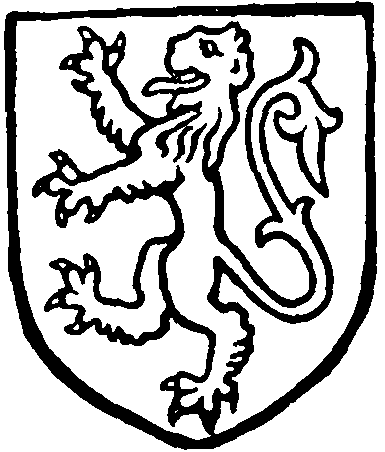
Lacy. Or a lion rampant purpure.
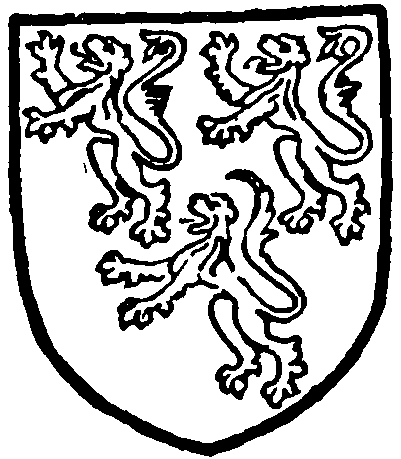
Talbot of Bashall. Argent three lions salient purpure.
Dower from the manor was in 1325 allowed to Margaret widow of Thomas de Hautrey, (fn. 13) but the Talbots continued in possession till 1328, (fn. 14) when John son of Edmund Talbot sold his right to Gilbert de la Legh. (fn. 15) Gilbert's son John married one of the co-heirs of Towneley, and had two sons Gilbert (without issue) and Richard. The latter and his issue succeeded to the whole inheritance of Hapton and Towneley, and having adopted Towneley as his surname, the story of his family is more properly related under that manor. (fn. 16)
The old residences of the lords of the manor are denoted by Hapton Castle and Hapton Tower. (fn. 17) The chief incident of the Towneley tenure was the imparking of a large part of the township in 1514. (fn. 18) The services of the park-keeper were in dispute in 1546 and later. (fn. 19) A survey of the manor made about 1645 states that the number of acres within the manor was 1,857; the rents amounted to £218 10s. 1d., besides fines and foregifts; when a tenant died double rent was paid to the lord as relief; the lord had the right to keep a court baron twice a year, but no courts had been held for forty years. (fn. 20)
In 1632 Christopher Towneley of Hapton compounded for the two-thirds of his estates liable to sequestration for recusancy by an annual fine of £20, and Jane Towneley by one of £63 6s. 8d. (fn. 21) Jane was the widow of Richard Towneley of Towneley, and Christopher one of her sons. He is noteworthy as the transcriber of the numerous volumes of deeds to which later historians have been greatly indebted; he afterwards lived at Carr Hall and Moorhiles, and was buried at Burnley in 1674. (fn. 22)
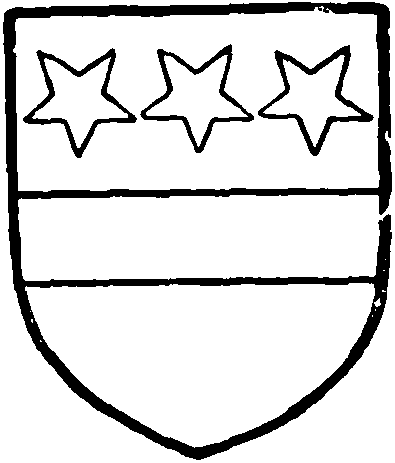
Towneley of Towneley and Hapton. Argent a fesse sable, in chief three mullets of the second.
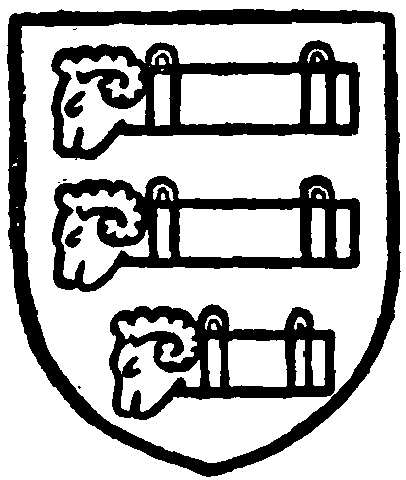
Bertie, Earl of Abingdon. Argent three battering-rams barways in pale proper headed and garnished azure.
The present lord of the manor is the seventh Earl of Abingdon, in right of his first wife Caroline Louisa, eldest daughter and co-heir of Charles Towneley. No courts are held.
BIRTWISLE (fn. 23) was assessed separately as half a plough-land, and held in socage of the lord of Clitheroe by a rent of 4s. Robert de Lacy, who died in 1193, granted it to Eudo de Lungvilers at that rent, the forest and wild beasts therein being reserved to the grantor. (fn. 24) In 1209 Reyner son of Ralph claimed the 4 oxgangs of land in Birtwisle against Eudo, who allowed him 3 oxgangs on the east side at a rent of 6s., reserving to himself the oxgang on the west; 20 acres formerly held by Thomas son of Gospatrick were allowed to Eudo, who gave Reyner an equal amount of land in his western oxgang. (fn. 25) Before the end of the 13th century the manor was acquired by John de Lacy of Cromwellbottom, (fn. 26) whose descendant Henry in 1356 sold it to Gilbert de la Legh. (fn. 27) Gilbert, as above related, inherited the principal manor of Hapton, and from that time Hapton and Birtwisle were held together. (fn. 28) Ultimately the latter was lost sight of. (fn. 29)
The family of Birtwisle probably descended from the Reyner of 1209. In 1253–4 John son of Reyner son of Ralph called upon John son of Eudo de Lungvilers to observe the conditions of the fine of 1209. (fn. 30) John de Birtwisle, possibly the same, claimed land in Birtwisle against Henry de Lacy Earl of Lincoln, whose defence was that Birtwisle was neither town nor borough, but only a hamlet in Hapton, which the plaintiff could not gainsay. (fn. 31) It is not possible to trace the various branches clearly. One part of the estate was sold to John de Towneley in 1394 by Nicholas de Kighley and Joan his wife, she being a daughter of Adam son of Gilbert de Birtwisle. (fn. 32) Adam de Birtwisle had in 1353 claimed an oxgang of land in Hapton against Henry son of John de Lacy. (fn. 33) In 1397–8 the feoffees regranted to John de Towneley various manors, &c., including that part of the manor of Birtwisle which had belonged to Adam de Birtwisle and that part which had belonged to Henry de Lacy. (fn. 34) Nicholas Towneley and Richard Birtwisle were landowners in Hapton in 1524. (fn. 35)
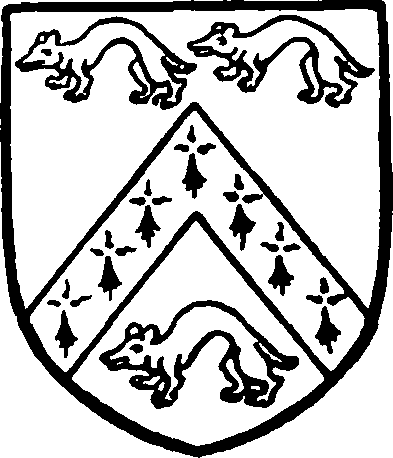
Birtwisle of Huncoat. Sable a cheveron ermine between three weasels passant argent.
Reyner de Birtwisle gave to the church of Whalley 3 acres in Birtwisle on the east side of the culture called Old Tunstead and another half acre. (fn. 36)
Another family of Birtwisle is more closely connected with Huncoat. John Birtwisle of Huncoat died in 1617 holding a messuage in Hapton of Richard Towneley in socage by a rent of 3s. (fn. 37)
SHUTTLEWORTH, (fn. 38) another ancient portion of Hapton described as a manor, gave a surname to a family still seated in the neighbourhood. Henry de Shuttleworth died before 1325 holding lands in Shuttleworth of John son and heir of Edmund Talbot by a rent of 4s. and six barbed arrows. John his son and heir was twenty-two years of age. (fn. 39) Another Henry died a little later, in 1329, holding a messuage and land in Shuttleworth of John de Thornhill by a rent of 4s. yearly; his heir was a son Henry, thirty years old. (fn. 40) At that time therefore, unless there is some mistake in the record, Shuttleworth was divided into two almost equal estates. (fn. 41) These may have been reunited later, but in 1384–5 the 'manor' was held by Richard son of Henry de Shuttleworth. (fn. 42) The principal estate here passed to Legh (fn. 43) and Talbot, (fn. 44) and by co-heiresses to Ashton of Chadderton and Shakerley. (fn. 45) The estate was purchased by the Starkies in 1734 and is now the property of Mr. E. A. Le Gendre Starkie of Huntroyde. (fn. 46)
SHUTTLEWORTH HALL, now a farm-house, stands on high ground at the north-west end of the township and is a picturesque H-shaped 17th-century building of two stories, with mullioned and transomed windows and stone slated roofs. The walls are of coursed rubble masonry with dressed quoins and the end gables are quite plain without coping. There is a smaller coped gable over the porch, which goes up the full height of the house in the angle formed by the middle and east wings. The two end gables have each an attic window of three lights, the middle one of which is raised, the heads of the side lights being curved inwards, forming a species of ogee arch with flat top, a characteristic of many of the gable windows in houses in the district of Worsthorne. The building has been a good deal restored and some of the windows are new, but it retains all its original external characteristics. The windows in the end wings are of six lights and those in the middle wing on both floors of eight lights, all with hood moulds. The upper part of the porch slightly projects and the outer doorway has a flat four-centred arched opening with moulded jambs and head. The porch is open with a stone seat on either side, and the inner door is the original nail-studded one of oak with ornamental iron hinges. Over the outer doorway is a lead panel, probably belonging to a former spout head, with the date 1639. The interior is modernized. The front of the house faces south and looks on to a garden extending its full length of 75 ft. and about 50 ft. wide in front of the end wings, inclosed by a stone wall with moulded coping and entered in the middle under a segmental-headed gateway with picturesque stepped gable over. The arch and jambs have been rebuilt, but the wall and gable, which is surmounted by a ball ornament, are original. Worked on to the coping of the east return of the fence wall is the octagonal shaft of a small sundial bearing the initials C. H., the plate of which has disappeared.
Bradley (fn. 47) was divided chiefly between the families of Towneley (fn. 48) and Habergham. (fn. 49) Lawrence Habergham died in 1615 holding two messuages in Bradley of Richard Towneley in socage by a rent of 16s. 4d. (fn. 50) Collinhouse, (fn. 51) Reedley (fn. 52) and Bentley (fn. 53) are also mentioned in the deeds. Arbitrations concerning Bullock Ees were made in 1584 and 1621. (fn. 54)
The GREEN in Hapton, now Padiham Green, was granted by William de Arches to Thomas the Clerk of Altham under the name of Kagildegrene at a free rent of 3s. 6d. (fn. 55) Roger son of Thomas de Altham gave the same to Thomas his son, (fn. 56) who appears to have adopted Green as his surname. In 1304 Thomas de la Green gave Cagildegrene in Hapton to his son Roger, together with the homage of his brother Henry. (fn. 57) John de Hautrey and Maud his wife had given land in Hapton to their servant Roger, probably the same person. (fn. 58) In 1334 Thomas de Simonstone complained that Gilbert de la Legh had made a wrongful distraint in 1328. He said that one Thomas atte Green had held a messuage and land of Thomas de Hautrey, then lord of Hapton, by a rent of 3s. Hautrey gave the manor to Legh, who was disseised by Edmund Talbot, after which Green appears to have been compelled to pay 10s. rent. He gave his holding to John de Huncoat, whose son Richard gave to plaintiff. Then Gilbert recovered the manor, and, not being content with the old 3s. rent, required 10s. to be paid and seized upon goods till his demand was satisfied. (fn. 59) The Greens (fn. 60) were in the 15th century (fn. 61) succeeded by a family named Ryley, who continued there for about 200 years (fn. 62); the estate was then sold to the Starkies of Huntroyde. (fn. 63)
A few other holders occur in the records. (fn. 64)
The bounds of Hapton, Huncoat and Henheads were surveyed in 1597. (fn. 65)
There were seventy-eight hearths liable to be taxed in 1666. The largest house was that of—Ashton with twelve hearths; another house had five and three had three. (fn. 66)
Charles Towneley paid over three-fourths of the land tax in 1787; Le Gendre Starkie paid about half the remainder. (fn. 67)
For the Church of England service is held in the schoolroom at Hapton and also in the unfinished church of SS. Ann and Elizabeth, Padiham Green, 1873, by one of the clergy of the church at Padiham. The schoolroom at Clow Bridge is served from Goodshaw.
The Wesleyan Methodists have a chapel at Hapton village.
In 1626 William Eaves and seven other convicted recusants were recorded in Hapton. (fn. 68) The schoolchapel of St. John the Baptist was built at Padiham Green for the local Roman Catholics (fn. 69) in 1863, and was for some years served from Burnley. The present church was built in 1881.
